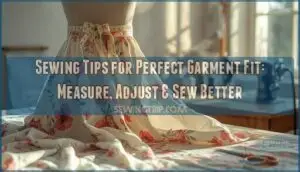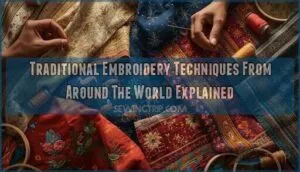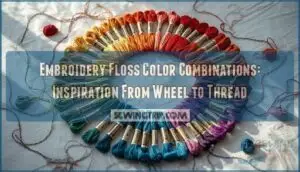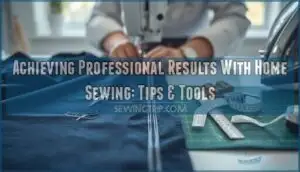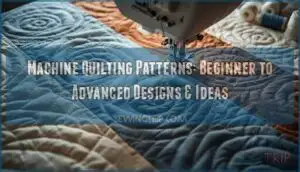This site is supported by our readers. We may earn a commission, at no cost to you, if you purchase through links.
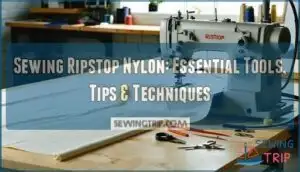 Ripstop nylon laughs at conventional sewing wisdom. This engineered fabric—woven with reinforcement threads in a crosshatch pattern—slides under your presser foot like ice on glass, puckers without warning, and punishes dull needles with permanent damage to its grid structure.
Ripstop nylon laughs at conventional sewing wisdom. This engineered fabric—woven with reinforcement threads in a crosshatch pattern—slides under your presser foot like ice on glass, puckers without warning, and punishes dull needles with permanent damage to its grid structure.
You can’t treat it like cotton or even standard synthetics. The material demands specific tools: needle geometries that slip between yarns instead of splintering them, presser feet that glide rather than grip, and clips that secure without puncturing the waterproof coating you’re trying to preserve.
Master these technical requirements, and you’ll transform slippery, stubborn fabric into professional outdoor gear, ultralight bags, or weather-resistant projects that actually hold together under stress.
Table Of Contents
Key Takeaways
- Ripstop nylon requires specialized tools—Microtex sharp needles (70/10 or 80/12), roller or walking presser feet, and fabric clips instead of pins—to prevent damage to its reinforced crosshatch grid structure.
- Success with this slippery synthetic depends on three fundamentals: matching needle size and tension to fabric weight, controlling material through clipping rather than pinning, and choosing appropriate seam finishing techniques like French seams or flat-felled seams.
- The fabric’s engineered properties demand lighter thread tension than cotton (around 3-4), longer stitch length (3.0-3.5mm), and gentle fabric guidance to prevent puckering, skipped stitches, or permanent grid damage.
- Don’t prewash ripstop nylon—it strips the water-repellent treatments and compromises the tear-resistant properties that define its performance in outdoor gear and weather-resistant projects.
Essential Tools for Sewing Ripstop Nylon
Working with ripstop nylon demands precision tools that won’t fight the fabric’s slippery, tear-resistant nature.
The right tools make all the difference—especially ones built to handle this slippery, synthetic material without snagging or leaving your sewing machine throwing a fit.
Here’s your essential toolkit for transforming ripstop nylon into durable, professional-grade projects.
MumCraft Multipurpose Sewing Clips Assorted Colors Pack of 100
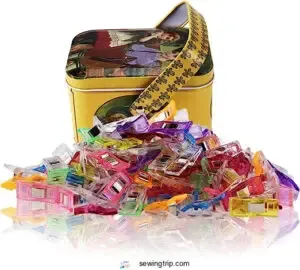
When ripstop nylon’s slippery surface makes traditional pins your worst enemy, these 100 colorful clips become your secret weapon for keeping layers exactly where you need them. MumCraft Multipurpose Sewing Clips offer premium fabric grip without puncturing your material, ensuring your sewing machine glides smoothly over secured seams. Their color coding system streamlines clip organization across multiple projects, while their outstanding clip durability withstands repeated use when sewing ripstop nylon fabric with demanding nylon threads and weaving techniques.
- Enhanced sewing efficiency: Wide-opening jaws accommodate thick fabric bundles while maintaining constant tension throughout your stitching process
- Presser foot compatibility: Flat bases won’t interfere with your sewing techniques, allowing smooth transitions from pinning to stitching
- Professional-grade construction: Heat-resistant plastic withstands friction and pressure without cracking or losing spring tension
Schmetz Size 70/10 Microtex Sharp Needles
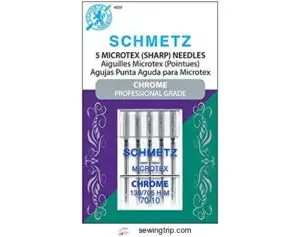
Your needle choice matters just as much as those clips—the wrong one will punch visible holes or skip stitches, turning precision work into a frustrating mess.
Schmetz Size 70/10 Microtex Sharp Needles pierce ripstop nylon fabric cleanly without distorting weave patterns, maintaining ideal thread tension while delivering professional stitch quality at controlled sewing speeds.
| Feature | Benefit for Ripstop Nylon |
|---|---|
| Ultra-fine 70/10 diameter | Minimizes fabric piercing damage on lightweight materials |
| Acute needle point geometry | Penetrates tight nylon weaves without snagging fibers |
| Precision-ground shaft | Reduces friction for consistent sewing techniques |
Roller Sewing Machine Presser Foot Teflon NonStick
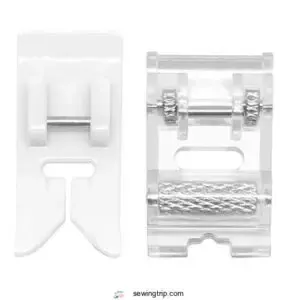
Even the best needle won’t help if your fabric keeps sticking to the presser foot—that’s where a specialized roller foot changes everything. The Roller Sewing Machine Presser Foot with Teflon coating eliminates drag on slippery nylon threads and coated materials, delivering consistent stitch formation where standard feet fail. This nonstick surface lets you control feed rate precisely while the rotating roller mechanism prevents puckering across multiple fabric layers.
Key advantages for sewing ripstop nylon fabric:
- Teflon coating reduces friction on water-repellent nylon surfaces, preventing fabric bunching during critical seam construction
- Roller feet maintain even pressure distribution, essential when weaving through reinforced crosshatch patterns
- NonStick surfaces accommodate silicone or polyurethane-treated materials without residue transfer
- Universal compatibility with low-shank sewing machines expands your technical capabilities for diverse projects
- Durable construction withstands repeated use on abrasion-resistant synthetics, delivering professional sewing tips for years
Even Feed Walking Foot Sewing Machine Quilt Guide Presser Foot
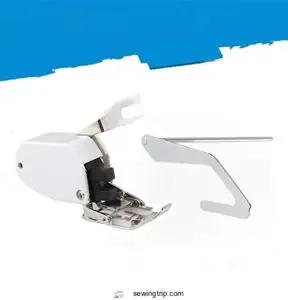
When ripstop nylon fights back with shifting layers or uneven seams, you need a walking foot‘s dual-feed mechanism to lock everything in place. This even feed presser foot synchronizes top and bottom fabric movement through sewing machines, eliminating layer drift that plagues coated materials.
The included quilt guide ensures parallel seam precision—critical when sewing ripstop nylon fabric where misalignment compromises structural integrity.
Compatible with most low-shank sewing machine accessories, this walking foot delivers the control you need for professional results on challenging synthetics.
Sewing Tips and Tricks
Working with ripstop nylon comes down to three fundamentals that’ll save you hours of frustration and give you cleaner results.
Start with the right machine setup for ripstop’s weight. You’ll want a Microtex sharp needle in 70/10 or 80/12—these cut through cleanly without catching those reinforcement threads.
Dial back your thread tension a notch from what you’d use for cotton, and bump stitch length up to 3.0–3.5mm. This keeps you from punching too many holes that’ll compromise your seam strength.
When it comes to handling the fabric itself, precision matters at every stage. A sharp rotary cutter or good scissors make all the difference—clean cuts mean edges that won’t unravel on you.
Skip the pins and grab fabric clips instead; they hold layers together without warping that slippery material.
Once you’re at the machine, let the fabric feed naturally under the presser foot. Fighting it by pulling or pushing just creates problems down the line.
Finally, match your seam finishing to what the project actually needs:
- French seams encapsulate raw edges for clean, waterproof joins
- Flat-felled seams distribute stress across high-wear zones
- Zigzag stitching prevents unraveling without adding bulk
- Seam tape reinforces stress points on packs and shelters
- Topstitching secures layers while maintaining fabric integrity
Master these fundamentals and you’ll handle ripstop like a pro.
Frequently Asked Questions (FAQs)
Is ripstop nylon hard to sew?
Sewing ripstop feels like working on a slippery slope at first. But once you’ve prepped your fabric, grabbed a sharp needle, and dialed in your tension, those challenges smooth out fast.
With proper thread selection and nylon threads suited for your sewing machine, weaving ripstop nylon fabric becomes straightforward rather than intimidating.
Can a regular sewing machine sew nylon?
Yes, your sewing machine can manage nylon threads and nylon fabric with the right setup.
Use sharp needles (size 70/10–80/12), adjust machine tension, control sewing speed, guarantee smooth fabric feed, and keep up with sewing machine maintenance for best results.
What is the hardest fabric to sew?
Over 60% of sewers rank leather and vinyl among the hardest fabrics to sew.
Delicate fabrics, slippery silk, stretchy knits, and thick canvases like heavy-duty upholstery all throw curveballs at seasoned sewers—whether it’s fabric that won’t feed through smoothly or needles that struggle to punch through.
What are the disadvantages of ripstop nylon?
Despite its strength, ripstop nylon has drawbacks, including heat sensitivity—melting under high temperatures—and limited breathability compared to natural fibers.
Additionally, its slippery manipulation during cutting and sewing poses challenges. These fabric weaknesses and material constraints demand careful technique when working with nylon fabric.
Working with ripstop nylon takes some know-how—you’ll need to pay close attention to how the material behaves and what it needs to stay in good shape.
What are some recommended projects for beginners starting with ripstop nylon?
Start your journey by tackling a drawstring bag—you’ll build confidence while mastering cutting, hemming, and channel construction.
Graduate to practical outdoor gear like stuff sacks or rain covers, perfect for honing your sewing machine skills with ripstop nylon fabric.
How do I prevent ripstop nylon from fraying?
To prevent fraying, use a hot knife or sharp rotary cutter for clean edge sealing during cutting techniques.
Apply fray-check liquid to raw edges, or employ French seams and seam reinforcement for durable fabric finishing when sewing ripstop nylon fabric.
Can ripstop nylon be sewn by hand?
Hand-sewing ripstop nylon? Sure, if you’ve got time to wrestle slippery fabric and endless patience.
Yes, you can hand-sew ripstop nylon fabric using a microtex needle, nylon thread, and backstitch patterns—just prepare for deliberate, careful stitches that demand precision beyond machine sewing.
What tension settings work best for ripstop?
You’ll want to set your thread tension slightly looser than usual—around 3 to 4 on most sewing machines—to prevent puckering and perforation.
Pair this with a Microtex needle, proper stitch regulation, and balanced fabric feed for clean seams on ripstop nylon fabric.
How do I repair holes in ripstop?
A clean tear through ripstop nylon fabric demands immediate damage control. Catch it before the grid pattern fails.
Apply a self-adhesive ripstop restoration patch over the hole, then reinforce with a tight zigzag stitch using nylon thread for waterproofing and water resistance.
Should I prewash ripstop nylon before sewing?
Skip prewashing ripstop nylon—it’s unnecessary and actually strips away the water repellency treatments the manufacturer applied during production. Prewashing weakens both the tear resistance and the fabric’s protective coatings.
Instead, focus on proper fabric selection and care by choosing quality ripstop nylon fabric and maintaining its engineered properties throughout your sewing process.
Conclusion
Ever wonder why some homemade gear falls apart while others last for years? It comes down to one thing: working with ripstop nylon’s grid structure instead of fighting against it.
Homemade gear lasts when you respect ripstop nylon’s grid structure instead of fighting it
Now you’ve got the needle geometry, presser foot mechanics, and securing techniques that stop grid damage cold while keeping everything waterproof.
This isn’t about clever hacks—it’s about matching your tools to how the material actually works.
Stick with these fundamentals, and ripstop suddenly makes sense. That ultralight pack you’ve been planning? It’ll do more than survive a few trips—it’ll handle whatever you throw at it, just like the engineers intended.
- https://www.mh-chine.com/blog/products/fabric-ripstop-nylon
- https://www.sunfengtex.com/blog/evaluate-tear-strength-ripstop-nylon
- https://www.performancedays.com/loop/focus-topic/2021-12-the-sustainable-future-of-nylon.html
- https://www.marketresearchfuture.com/reports/nylon-fiber-market-2628
- https://www.idealabgz.com/post/working-with-ripstop-nylon-for-lightweight-durable-bags-a-guide-for-custom-backpack-manufacturers

